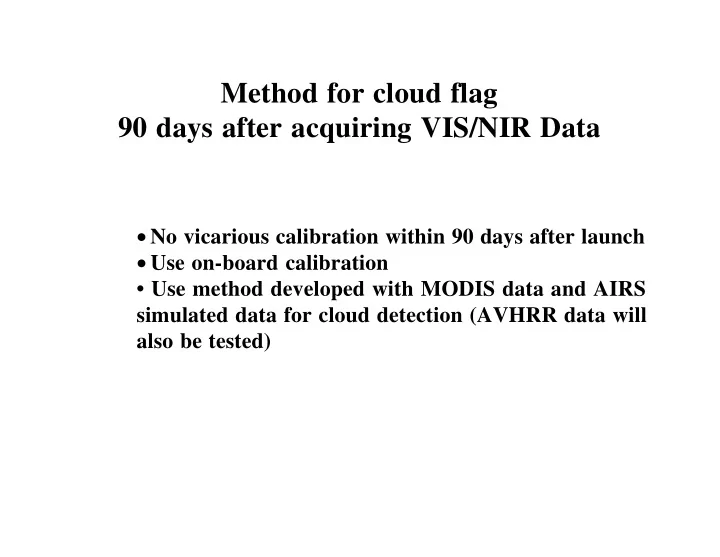

Method for cloud flag 90 days after acquiring VIS/NIR Data • No vicarious calibration within 90 days after launch • Use on-board calibration • Use method developed with MODIS data and AIRS simulated data for cloud detection (AVHRR data will also be tested)
Method • Use on-board calibrated AIRS VIS/NIR channel 1, 2 and 3 data • Make false color composite image R (Ch 3), G (Ch 2), B (Ch 1) • Enhance low radiance parts to enhance clouds. • if large offsets need to be correct for
Offset Correction • Check the dynamic range for each channel Rxmax for x = 1 , 4 Rxmin • Normalize channel data (R2max - R2min) R1 = (R1 - R1min) * + d1 (R1max - R1min) R2 = R2 - R2min + d2 (R2max - R2min) R3 = (R3 - R3min) * + d3 (R3max - R3min)
Offset Correction (Continued) Image Processing technique in-lieu of calibration • false clear sky color composite image over ocean and land surface • check the linearity of each channel (compare with model or MODIS values for some typical ground targets) • Gamma correction may be required (exponential = high enhancement, square root = low enhancement) • Process to be repeated in calibration process
Cloud Detection (1) • use software developed for simulated AIRS data (MODIS image) • adjust lookup table “gain_offset.inc” and, if necessary, lookup table “ vis_data_load.inc ” to detect the clouds. • “ vis_data_load.inc ” used to remove atmospheric anisotropic effect • Estimated anisotropy effect close to measured data (see Angular Radiation Models for Earth-Atmosphere System, NASA Reference Publication 1184, 1988) • Anisotropy effect also seen in AVHRR data in clear sky over ocean surface)
Cloud Detection (2) • “ vis_data_load.inc ” corrections appear good for MODIS data. • If the anisotropy effect of AIRS VIS/NIR different, table will be modified • “ gain_offset.inc ” used to satisfied units used, e.g, to make the cloud detection algorithm works for DN number instead of W/m2/str/µm.
Cloud Detection (3) Algorithm has been modified (not tested in V2i.15) to use surface temperature derived from AIRS IR channel around 11 µm to detect thin cirrus cloud as follows (we use MODIS channel 31 for test now) - Run cloud detection algorithm to find clear sky (over ocean, sand and vegetation surfaces) - Calculate maximum and minimum IR temperature for 3 x 3 AMSU footprints (about 135 x 135 km) - If IR measured temperature lower than maximum IR temperature for a given value or temperature lower than given temperature (e.g., 6 to 8 degree below freezing temperature over ocean surface), IR footprint is assumed to contain cirrus clouds
Recommend
More recommend